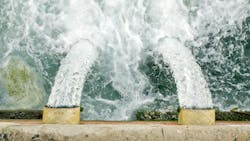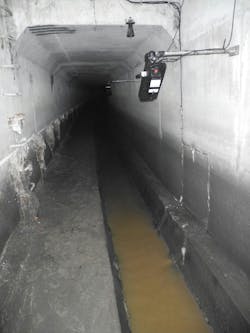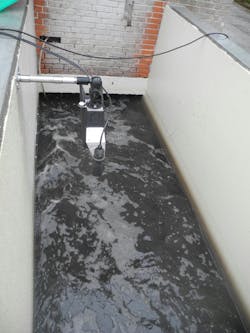How advanced flowmeters are helping utilities tackle I&I and reduce sewer overflow risk
Key Highlights
- Modern flow sensors provide real-time data crucial for detecting inflow and infiltration issues, helping prevent costly overflows.
- Advanced devices feature replaceable sensors and open protocols, reducing maintenance costs and enabling system upgrades without full replacements.
- Non-contact radar and ultrasonic sensors improve safety and accessibility by measuring flow without physical water contact, ideal for confined spaces.
Calculating flow through sewer and stormwater pipes is becoming increasingly more important for municipal wastewater treatment operations. State and federal regulations are focusing more attention on mitigating pollution caused by sanitary sewer overflows and combined sewer overflows, and state and city governments across the country are becoming more concerned with the flow of stormwater as more frequent and extreme flooding poses a growing threat to life and property.
Modern flow sensors, designed for real-world conditions, help utilities conduct more reliable inflow and infiltration (I&I) studies, reduce the risk of overflow during peak-flow conditions, improve planning and response with real-time flow data and lower maintenance costs with compact, low-touch deployments.
Not all flowmeters are created equal, so facility operators are wise to compare functionality when investing in these sensors.
The high price of I&I continues to plague municipal wastewater
I&I are a scourge on wastewater treatment systems and are especially prevalent in older ones that suffer from cracks and deterioration. It is estimated that as much as half of all water treated in municipal systems is a result of I&I, which is made even worse during heavy rain events.
The economic impacts of this influx of water on a network include higher pumping and treatment costs, strain and wear on infrastructure, and the fines, environmental contamination and other ill effects of overflows
As utilities work to better manage aging sewer infrastructures and reduce the impact of wet-weather events, accurate flow monitoring is becoming essential to understanding system performance and guiding smarter short- and long-term decisions in the field.
Flow is a calculation, not a measurement
To help utilities more quickly and appropriately respond to sudden changes in sewer line flow, the ability to calculate flow in real-time is an important feature in flowmeters.
Flow is the amount of water moving through a specific space in a given time. To calculate it, two pieces of information are necessary: the speed at which the water is moving (velocity) and the size of the space it’s moving through (area). If either velocity or area changes, flow changes too, which is why accurate measurement of both velocity and area are important in calculating the flow, or discharge, of a waterway.
Flow = Velocity x Area
Advancd flowmeter innovations deliver better data at lower costs
Modern flow sensors are helping utilities control costs and deftly adapt to tougher regulations and a more critical era of water management. Advanced flowmeter technology offers several valuable enhancements, including interoperable products with serviceable, swap-out parts.
Advanced flow sensors combine velocity and depth measurement in a single, compact device that calculates flow internally with no external controller needed. Real-time results are sent as data ready for use in SCADA or remote monitoring systems.
With particular relevance to cost control, utilities now can choose sensors with open protocol, which means the sensors’ universally readable data is highly compatible with other technology and can communicate with almost any other vendor system. This allows utilities to more easily and affordably retrofit their existing systems with upgraded devices without having to replace their entire system.
Another modern cost-cutting feature is a device’s ability to swap out the spent pressure level sensor, which typically lasts two to three years and is often the first part to fail. As the rest of the device can continue functioning much longer, replacing the entire device is wasteful and expensive. Devices with easily replaceable pressure level sensors, such as Flow-Tronic’s Beluga A/V submersible area velocity flowmeter, offer operational cost savings.
Sensors that can calculate flow from above the surface of the water, like the Raven-Eye 2+ non-contact radar flowmeter, offer several key advantages. Using pulse radar to continuously measure and monitor surface velocity and an ultrasonic sensor to measure water level, these sensors calculate flow without physically contacting the water. They are easy to access and service and minimize the challenges and hazards presented by confined spaces that increase the need for more workers and the risk to their safety.
Flowmeter data supplies critical operational information
More wastewater utilities are using advanced area-velocity flowmeters and sensors to detect I&I, track storm-related surges and collect EPA-required data for monitoring wastewater flow.
Wastewater treatment facility operators know that managing wastewater is often like flying blind, and advanced flowmeters are giving them better eyes on their underground systems. Through a range of innovative uses of proven technology such as digital spectral analysis, pulse radar and ultrasonics, data coming from modern sensors is highly accurate.
Because I&I causes both a high operating cost and damage that can lead to greater capital expenses, investigating its source is a worthy investment. Accurate flowmetering helps identify locations of I&I so that it can be diagnosed and fixed before greater damage requires a major repair.
During heavy rain events, which are becoming more frequent and more severe, real-time flowmetering can provide the data needed to initiate discharge into a catch basin and avoid an overflow. This technology also can be installed in drainage ditches and stormwater channels, and when combined with hydraulic models, can help alert local officials of pending flood conditions.
When utilities accept the wastewater from other utilities for treatment, calculating flow, and sometimes quality, is paramount for accurate assessment and billing. Both sending and receiving utilities can benefit from flow sensors for custody transfer billing and surcharge monitoring, ensuring that bills are accurate.
For long-term capital planning, flow measurement data provides the critical information needed to make solid, proactive decisions on when and where to repair, upgrade and expand. Large capital projects based on incomplete information can miss the mark and result in unnecessary expense or an upgrade that doesn’t deliver intended results.
Recognizing the value of flowmeter features
Companies like Flow-Tronic engineer long-lasting, highly accurate flowmeters that help utilities save costs with an open communication protocol and easy parts replaceability. Badger Meter, which has an OEM agreement with Flow-Tronic, has experienced strong results from these products with their customers.
“We are striking a chord with our customers with the industry-exclusive ability to replace the pressure level sensor on the Beluga A/V and not having to replace the whole device when the sensor reaches the end of its life,” said Matt Menzel, director of global product management with Badger Meter. “Cutting waste and cost is a high priority across the municipal wastewater industry, and the reliability, durability, accuracy and parts replaceability of Flow-Tronic’s products are receiving a warm reception from our customers.”
With replaceable level sensors, a completely sealed design that does not require annual certification, and remote diagnostic alarming capabilities for unexpected movement, these products eliminate the need for unnecessary field maintenance visits. Additionally, the extended useful life of the sensors provides a higher return on investment compared to other solutions in the market.
Investing in flowmeters can lower cost and risk
As utilities seek to reduce costs and respond to regulatory pressure to reduce overflows, tackling I&I is the obvious first step. Advanced flow measurement is a cost-effective way to achieve the system visibility necessary to investigate the locations and causes of I&I, monitor difficult and remote flow locations, comprehend the real-time impact of major rain events, prevent overflows, and assist in community flood mitigation. Modern flow calculation devices make all this possible while also reducing cost, maintenance and risk.
About the Author

Vincent Favre
Vincent Favre is an experienced Director with a demonstrated history of working in the environmental services industry. Skilled in water conservation, flow monitoring instrumentation, managing distribution channels and OEM partnership, Vincent has been involved in the water and wastewater industry since 1998.


